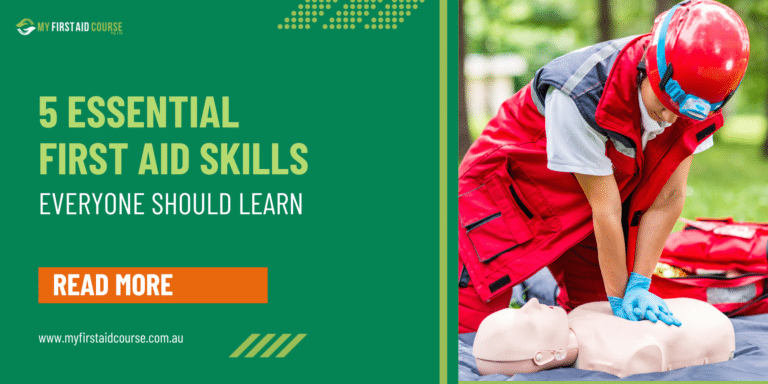Living in Brisbane, or anywhere in Australia, means coexisting with a diverse range of wildlife, including various species of spiders. While most spider bites are harmless, knowing first aid can make a difference with the more dangerous spiders. This guide aims to equip you with the necessary knowledge to handle spider bites effectively. Here’s some information on spider bites we cover in our comprehensive training.
Spider Types
Australia is renowned for its diverse and sometimes dangerous wildlife, and spiders are no exception. Understanding the types of spiders you may encounter and their potential dangers is the first step in being prepared.
Redback Spider (Latrodectus hasselti)

Identification: The redback spider is easily recognizable by the distinctive red or orange stripe on its back. Females are more dangerous and are usually around 1 cm in length, whereas males are much smaller and less harmful.
Habitat: Redbacks are common throughout Australia and are often found in urban areas, hiding in dry, sheltered locations such as sheds, garages, and under outdoor furniture.
Bite Symptoms: The bite of a redback spider can cause severe pain, which may spread to other parts of the body. Other symptoms include sweating, nausea, vomiting, and muscle pain.
Funnel-Web Spider (Atrax robustus and Hadronyche spp.)

Identification: The funnel-web spider is robust, with a glossy, darkly coloured body.
Habitat: Funnel-web spiders are found in moist, cool environments, often in burrows or under rocks and logs. They are native to the eastern coast, including Brisbane. (However it’s this variety near sydney that is particularly bad)
Bite Symptoms: A funnel-web spider bite is extremely dangerous and potentially life-threatening. Symptoms can include severe pain at the bite site, muscle spasms, sweating, and difficulty breathing. Immediate medical attention is required.
White-Tailed Spider (Lampona cylindrata and Lampona murina)

Identification: These spiders have a cylindrical body with a distinct white patch at the end of their abdomen. They are typically around 1-2 cm in length.
Habitat: White-tailed spiders are commonly found indoors, often hiding in bedding, clothing, and towels.
Bite Symptoms: Bites can cause local pain, itching, and swelling. In rare cases, ulceration of the skin may occur, leading to a slow-healing wound.
Wolf Spider (Lycosidae family)
Identification: Wolf spiders are large, hairy spiders with a distinctive eye arrangement – four large eyes on the top row and four smaller eyes below.
Habitat: They are ground-dwellers, often found in gardens, forests, and grassy areas.
Bite Symptoms: Their bite is generally harmless, causing mild pain, itching, and swelling.
First Aid for Spider Bites
Administering the correct first aid promptly can greatly reduce the severity of symptoms and improve recovery outcomes. Here’s a detailed guide on what to do if you or someone else is bitten by a spider.

General Steps for Any Spider Bite
- Stay Calm: Panicking can worsen the situation by increasing your heart rate and spreading venom more quickly if it is present.
- Identify the Spider: If it is safe to do so, try to capture or take a photo of the spider for identification. This can assist medical professionals in providing the appropriate treatment. Google lens is your friend here.
- Clean the Bite Area: Use soap and water to clean the wound thoroughly. This helps to prevent infection and remove any venom on the surface of the skin.
- Apply Ice Pack: Use an cold pack to reduce pain and swelling. Wrap the ice pack in a cloth before applying it to the skin.
Specific Treatments for Different Spider Bites
Redback Spider Bite
- Apply Ice Pack: Place an ice pack on the bite area to reduce pain and swelling.
- Avoid Tight Bandages: Do not use a pressure immobilization bandage, as it can increase pain.
- Pain Relief: Administer over-the-counter painkillers such as paracetamol or ibuprofen if necessary.
- Monitor Symptoms: Watch for any systemic symptoms like nausea, vomiting, or muscle pain. If these occur, seek medical attention promptly.
Funnel-Web Spider Bite
- Apply Pressure Immobilization Bandage: This is very important. Wrap a bandage around the bitten area and immobilize the limb. You want it to be tight enough to have significant pressure on the affected area but not too much that it stops circulation. This slows the spread of venom. Start from the bottom of the affected limb and work your way up.
- Keep the Person Still: Movement can increase venom spread. Keep the person as still as possible.
- Call Emergency Services: Dial 000 immediately for an ambulance. Funnel-web spider bites are medical emergencies and require prompt professional treatment.
- Monitor Breathing : Be prepared to perform CPR if the person stops breathing.
White-Tailed and Wolf Spider Bites
- Apply Ice Pack: Helps reduce pain and swelling.
- Monitor for Infection: Look out for signs of infection such as increased redness, swelling, or pus.
- Seek Medical Advice if Needed: If symptoms worsen or an allergic reaction occurs, seek medical help.
When to See a Medical Professional
Knowing when to seek medical help can be lifesaving. Here are situations where you should consult a healthcare professional:
- Severe Pain or Swelling: If the pain is intense or the swelling is spreading rapidly.
- Systemic Symptoms: Symptoms like dizziness, difficulty breathing, chest pain, or muscle spasms.
- Signs of Infection: Increased redness, swelling, pus, or fever.
- Suspected Funnel-Web or Redback Spider Bite: These bites require immediate medical intervention.

Preventing Spider Bites
Prevention is always better than cure. Here are some practical tips to reduce the risk of spider bites:
In and Around the Home
- Regular Cleaning: Keep your home clean and clutter-free, especially in areas where spiders are likely to hide such as basements, garages, and sheds.
- Seal Gaps and Cracks: Ensure doors, windows, and other entry points are properly sealed to prevent spiders from entering your home.
- Remove Outdoor Debris: Keep gardens and yards free from piles of wood, leaves, and other debris where spiders might take shelter.
- Use Spider Repellents: Consider using natural or chemical repellents to keep spiders at bay.
Personal Precautions
- Wear Protective Clothing: When gardening or working in areas where spiders might be present, wear gloves, long sleeves, and long pants.
- Shake Out Clothing and Shoes: Always shake out clothing, shoes, and bedding before use, especially if they have been left on the floor.
- Be Cautious in Spider-Prone Areas: Exercise caution when reaching into dark or hidden spaces where spiders may be lurking.
Myths and Facts About Spider Bites
There are many myths surrounding spider bites that can cause unnecessary fear or lead to inappropriate first aid measures. Here are some common myths and the facts that debunk them:
Myth 1: All Spider Bites Are Dangerous
Fact: Most spider bites are harmless and cause only minor symptoms such as redness, swelling, and itching. Only a few species, such as the funnel-web and redback spiders, pose a significant risk to humans.
Myth 2: Applying a Tourniquet Is Helpful
Fact: Applying a tourniquet can do more harm than ado more harm than good by cutting off blood flow and potentially causing tissue damage. Pressure immobilization bandages are recommended for funnel-web spider bites, but not for others like the redback.
Myth 3: Spiders Frequently Bite Humans
Fact: Spiders generally avoid human contact and bite only when they feel threatened or are accidentally provoked.
Myth 4: All Spider Bites Cause Necrosis
Fact: While some spider bites, such as those from the white-tailed spider, may cause skin ulceration in rare cases, most do not lead to necrosis.
Conclusion
Spider bites can range from mildly annoying to life-threatening. Being knowledgeable about the types of spiders and the appropriate first aid measures can make a significant difference. Always err on the side of caution and seek medical advice if you’re unsure. We’d love you to learn more about what to do and practice bandaging for spider bites. Join one of our courses today!






